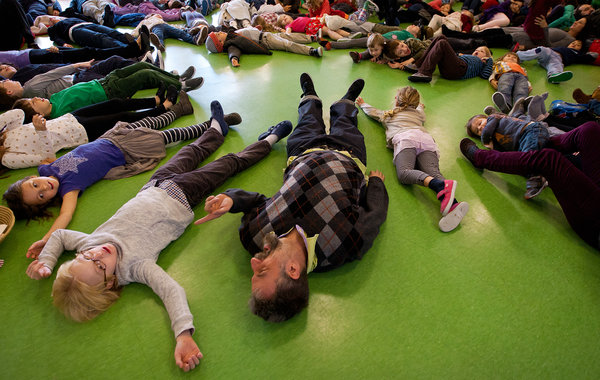Grappling so directly with thoughts and emotions may seem odd for such young brains, but it is part of the DNA of the Blue School, a downtown Manhattan private school that began six years ago as a play group. From the beginning, the founders wanted to incorporate scientific research about childhood development into the classroom. Having rapidly grown to more than 200 students in preschool through third grade, the school has become a kind of national laboratory for integrating cognitive neuroscience and cutting-edge educational theory into curriculum, professional development and school design.
“Schools were not applying this new neurological science out there to how we teach children,” said Lindsey Russo, whose unusual title, director of curriculum documentation and research, hints at how seriously the Blue School takes this mission. “Our aim is to take those research tools and adapt them to what we do in the school.”
So young children at the Blue School learn about what has been called “the amygdala hijack” — what happens to their brains when they flip out. Teachers try to get children into a “toward state,” in which they are open to new ideas. Periods of reflection are built into the day for students and teachers alike, because reflection helps executive function — the ability to process information in an orderly way, focus on tasks and exhibit self-control. Last year, the curriculum guide was amended to include the term “meta-cognition”: the ability to think about thinking.
“Having language for these mental experiences gives children more chances to regulate their emotions,” said David Rock, who is a member of the Blue School’s board and a founder of NeuroLeadership Institute, a global research group dedicated to understanding the brain science of leadership.
That language is then filtered through a 6-year-old’s brain.
Miles, one of the kindergartners drawing their emotions, showed off his picture and described the battle it depicted between happiness and anger this way: “The happy fights angry, but angry gets blocked by the force field and can’t get out.” Happiness could escape through his mouth, Miles explained. But anger got trapped, turning into sadness.
With ample research showing that negative emotions impede learning while positive emotions broaden children’s attention and their ability to acquire and retain information, strategies for regulating emotions are getting more emphasis in progressive schools across the country.
“The science of learning is something teachers are paying more and more attention to,” said Mariale Hardiman, director of the Neuro-Education Initiative at the Johns Hopkins University School of Education. She was not familiar with the Blue School but said she would endorse any school trying to integrate academic and emotional education.
“We can no longer think that the two systems are separate,” Dr. Hardiman said, “and that children should leave their emotions at the door.”
For all the attention brain science is receiving in schools, experts say it is too soon to know whether its application will lead to improved academic outcomes. And some researchers say that while they embrace new ideas — especially around self-control — they personally prefer a more traditional approach to pedagogy.
“The older approach has led to some very good outcomes,” said Sam Wang, an associate professor of molecular biology and neuroscience at Princeton University and co-author of “Welcome to Your Child’s Brain,” a child development primer for parents.
But the Blue School clearly has its appeal. This year, it had eight applications for each spot in its program for 3-year-olds, making it a typically hypercompetitive Manhattan private school. Tuition for students in kindergarten through third grade is $31,910 a year.
“I’m never anxious about academics,” said Thomas Bierer, the father of first-grade twins who have been at the school for two years. “My main thing is how they will interact with others and what kind of people will they be.”
Ruth Fremson/The New York Times
TRIP PLANNING Shanon Greenfield and her first-grade class carefully plotted a visit to the New York Aquarium in Coney Island.
Started in 2006 by members of the Blue Man Group, an alternative theater troupe, and their wives, the school’s original mission was to “reimagine education for a changing world.” The goal was to nurture creative and adaptive learners, not to teach students to digest and regurgitate facts and formulas. It considers itself a lab school, where teachers, parents and students collaborate; there are plans to have a teacher training program by 2013.
Teachers ask questions but rarely offer answers, instead helping students learn from one another. “Learning is not an individual act,” David Kelly, the school’s director of curriculum, said. “It’s a social act.”
In November, Shanon Greenfield asked her first graders what they wanted to study. Sharks and leaves each developed a strong following. Over weeks of discussion, the students decided they should go to an aquarium to learn more about one of the topics they had picked. Ms. Greenfield posted a road map for their research. What do they know? What do they want to know? How will they find it out?
The students set goals: Pick an aquarium, figure out how to get there, plan what to do while there and afterward. By mid-January, they were pondering transportation options: school bus (free) or ferry (one student thought it was most direct). They set a deadline for the trip, and in February visited the New York Aquarium in Coney Island — by bus.
“The end goal is not facts about sharks,” Ms. Greenfield said. “It’s not to recreate anything. The end goal is the process.”
Other progressive schools in Manhattan and across the country take a child-centered approach to education, with a heavy dose of social and emotional learning. But many of them turn toward a traditional academic curriculum by second or third grade. Testing, with all of its anxiety, kicks in, and content, not process, becomes paramount.
This being New York, even Blue School parents are not immune. Starting last year, when the oldest children in the school became second graders, parents began voicing increasing concern about the school’s lack of traditional assessments. The school had been preoccupied with moving almost every previous year. But with a permanent home established on Water Street, the parents, in town hall-style meetings and group discussions, asked the school to do more testing.
One parent who supported the push was David Beal, an adviser to the president of National Geographic, who noted that the school will end at fifth grade and that the children will be thrust into a test-happy world. “We don’t want to find out after we’ve left that we’ve missed some important chunk of learning,” he said.
The school responded. Four-year-olds are now being given a standard private school assessment, and this year for the first time, third graders will take the E.R.B., a widely used test.
Even with the changes, the Blue School is not for everyone. Emily Glickman, founder of Abacus Guide Educational Consulting, said her clients found it a “little too artsy and alternative.”
“I find more and more, for their tuition dollars, families want tradition, structure and the three R’s,” she said.
Dr. Daniel J. Siegel, a neuropsychiatrist and co-author of the parenting guide “The Whole-Brain Child,” who is also an adviser to the school, said there were three others R’s: reflection, relationships and resilience — and schools should teach those, too.
He spent three days at the school in late March working with students, teachers and parents on topics ranging from what learning is to why multitasking was not good for the brain (concentration is better at creating neural connections, which result in long-term synaptic change, otherwise known as learning). “Kids who learn social and emotional skills do better academically,” Dr. Siegel said. “They are happier, and their emotions are more rewarding.”
So what happens when you do too much multitasking, he asked some third graders. “Your brain explodes,” said one girl, squirming. “Ew.”







